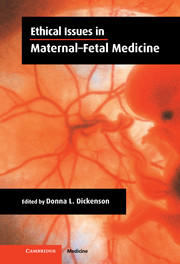Book contents
- Frontmatter
- Contents
- List of contributors
- Acknowledgements
- 1 Introduction: recent debates in maternal–fetal medicine – what are the ethical questions?
- 2 Overview: a framework for reproductive ethics
- I GENERIC ISSUES IN PREGNANCY
- II INCEPTION OF PREGNANCY: NEW REPRODUCTIVE TECHNOLOGIES
- III FIRST AND SECOND TRIMESTER
- IV THIRD TRIMESTER
- 17 Caesarean section: who chooses – the woman or her doctor?
- 18 Judgements of non-compliance in pregnancy
- V NEONATAL LIFE
- Index
17 - Caesarean section: who chooses – the woman or her doctor?
from IV - THIRD TRIMESTER
Published online by Cambridge University Press: 29 September 2009
- Frontmatter
- Contents
- List of contributors
- Acknowledgements
- 1 Introduction: recent debates in maternal–fetal medicine – what are the ethical questions?
- 2 Overview: a framework for reproductive ethics
- I GENERIC ISSUES IN PREGNANCY
- II INCEPTION OF PREGNANCY: NEW REPRODUCTIVE TECHNOLOGIES
- III FIRST AND SECOND TRIMESTER
- IV THIRD TRIMESTER
- 17 Caesarean section: who chooses – the woman or her doctor?
- 18 Judgements of non-compliance in pregnancy
- V NEONATAL LIFE
- Index
Summary
Caesarean section (CS) is a major operation which may be life-saving for mother or child. Like any major operation it carries risks, needs adequate anaesthesia and requires the informed consent of the woman.
The procedure
The woman may receive a general anaesthetic which renders her unconscious after injection of a suitable agent. Anaesthesia is then maintained with volatile gases, passed into the lungs via a tube in the trachea. Care has to be taken when the woman has been in labour that stomach contents are not regurgitated and inhaled into the lungs, as emptying of the stomach is delayed during labour. Because of this risk and the unhappiness that many women feel at not being aware of their baby's birth, regional anaesthesia is the preferred method today.
These methods involve passing a needle in between the vertebrae in the spine and injecting local anaesthetic agents, which requires considerable skill. There is a risk of the blood pressure falling, so an intravenous infusion is set up beforehand. If the woman has already had a catheter introduced into the epidural space to administer drugs to relieve pain, this can be topped up to give a higher degree of pain relief. Alternatively a spinal anaesthetic can be given, where the needle is passed into the cerebro-spinal fluid surrounding the spinal cord. This usually lasts about an hour, whereas the epidural can be maintained to give post-operative pain relief, if there are sufficient staff to monitor the woman adequately in the postnatal ward.
- Type
- Chapter
- Information
- Ethical Issues in Maternal-Fetal Medicine , pp. 263 - 284Publisher: Cambridge University PressPrint publication year: 2002
- 1
- Cited by

